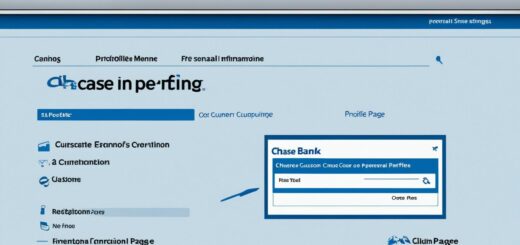Removing Someone From Your Bank Account Online
Have you ever wondered if you can remove someone from your bank account online? If you have a joint account and need to remove a co-owner, it is possible to do so through a specific process. Whether it’s a change in financial circumstances, a dissolution of a relationship, or any other reason, understanding the steps involved is essential.
Key Takeaways:
- To remove someone from a joint bank account online, you need to follow a specific process.
- Contact your bank, complete necessary forms, provide identification, secure consent, and potentially close and reopen the account.
- Consider the legal liabilities, reasons for removal, and the process of transitioning from joint accounts as minors become adults.
- Opening a new individual account and transferring funds can be the easiest option when removing a co-owner.
- Always consult with the bank for specific guidance and make informed decisions based on individual circumstances.
What Is a Joint Account?
A joint account is a bank account that is co-owned by two or more individuals. It allows all named account holders to have equal access and rights to the funds within the account. Joint accounts are commonly used by couples, business partners, or family members who share financial responsibilities, such as paying bills and managing household expenses. By pooling their resources into a joint account, they can streamline their finances and make it easier to manage shared costs.
Having a joint account implies shared ownership, where each account holder has an equal stake in the account. This shared ownership ensures that all individuals have an equal say in financial decisions related to the account. It also means that all account holders have equal access to the funds, irrespective of who contributes more or less. Joint accounts are built on the foundation of trust, transparency, and shared financial responsibilities.
Joint accounts can be advantageous for couples who want to combine their finances for easier bill payment, budgeting, and savings. It also allows them to establish a clear framework for sharing financial responsibilities and achieving common financial goals. For business partners, a joint account enables seamless management of shared business expenses and revenue. Family members who opt for joint accounts often do so to simplify the handling of their collective financial responsibilities, such as mortgage payments, household bills, or funding educational expenses for children.
Key Features of Joint Accounts:
- Shared Ownership: All named account holders have equal ownership and control over the account.
- Equal Access: Each account holder can access the funds within the account without any restrictions or limitations.
- Financial Responsibilities: All account holders share the responsibility of managing the account, including deposits, withdrawals, and bill payments.
- Transparency: Joint accounts require open communication and trust among the account holders to ensure that everyone is aware of the financial activities and decisions.
In summary, a joint account allows multiple individuals to co-own a bank account, providing equal access to the funds and shared financial responsibilities. This type of account is commonly used by couples, business partners, or family members who want to simplify their financial management and have a unified approach to their financial goals.
Steps to Remove Someone From a Joint Account
To remove someone from a joint bank account online, there are several steps you need to follow:
- Contact your bank: Begin the process by reaching out to your bank. This can be done by visiting a local branch, calling their customer service line, or checking their website.
- Obtain necessary forms: Different banks have different procedures for removing someone from a joint account. Contact your bank to find out what forms you need to complete. These forms typically require accurate information such as account numbers, names of account holders, and specific instructions for the removal.
- Provide identification: As part of the process, you will need to provide identification to verify your identity. This can include a driver’s license, passport, or any other accepted form of identification.
- Secure consent: Most joint accounts require the consent of all account holders for significant changes. If there are other individuals listed on the account, you will need to secure their consent before proceeding with the removal.
- Consider closing and reopening the account: If your bank does not allow for straightforward removal of an individual’s name from a joint account, you may need to consider closing the existing account and opening a new individual account or another joint account with the desired account holders.
Following these steps will help guide you through the process of removing someone from a joint account. It’s important to contact your bank directly to understand their specific requirements and procedures.
Legal Liabilities When Removing a Name From a Joint Bank Account
When removing a name from a joint bank account, it is crucial to consider the legal liabilities associated with this action. Failure to navigate the process properly can result in various consequences, including penalties, legal actions, and future disputes.
A breach of the bank’s agreement or any private agreement between co-owners can lead to legal repercussions. It is essential to adhere to the terms and conditions outlined by the bank and honor any existing agreements to avoid facing penalties or potential legal actions.
If the joint account has outstanding debts or obligations, all parties involved may be jointly and severally liable for those debts. Removing a name from the account does not absolve the individuals from their financial responsibilities. Therefore, it is vital to address any outstanding debts before proceeding with the removal process.
Transferring funds during the removal process may have tax implications. It is advisable to consult with a tax professional or seek guidance from the bank to understand the potential tax consequences and ensure compliance with relevant tax laws.
Unauthorized removal of a name or funds from a joint account can be considered misappropriation or theft. It is crucial to obtain proper consent and follow the appropriate procedures to avoid potential legal repercussions.
In cases of divorce or separation, removing a name from a joint account without following legal protocols can complicate asset division and financial settlements. It is advisable to consult with legal professionals who specialize in family law to ensure compliance with applicable regulations.
In the event of the death of an account holder, specific legal procedures may apply. Removing a name from a joint account requires adherence to these protocols to address the deceased individual’s assets and liabilities properly.
Failure to navigate the removal process can result in future legal disputes and complications. It is crucial to seek professional advice, consult with the bank, and follow the necessary legal procedures to mitigate potential legal liabilities and ensure a smooth transition.

| Legal Liabilities When Removing a Name From a Joint Bank Account |
|---|
| Breach of agreement |
| Outstanding debts |
| Tax implications |
| Misappropriation |
| Divorce or separation |
| Death of account holder |
| Future disputes |
Reasons Why Someone Might Need to Be Removed
There are several factors that can lead to the need for removing someone from a joint account. These range from personal circumstances to financial concerns, and include:
- Dissolution of relationship: When a romantic relationship, such as a marriage or partnership, comes to an end, separating joint assets, including bank accounts, becomes necessary. Removing someone from a joint account ensures a clean break and division of shared finances.
- Death of account holder: In the unfortunate event of the death of a joint account holder, their name needs to be removed to address their financial affairs and facilitate the proper distribution of assets.
- Financial mismanagement: If one of the joint account holders exhibits poor financial management skills, such as excessive spending, incurring debts without consent, or engaging in fraudulent activities, removing their name can protect the other account holders from further financial harm.
- Trust issues: Trust is an essential element in any joint account. When trust is compromised due to misuse or unauthorized access to funds, removing the untrustworthy account holder becomes necessary to restore stability and safeguard the account’s integrity.
- Desire for financial independence: Individuals may choose to remove themselves from a joint account to assert their financial independence and establish their own financial identity. This desire for autonomy can be driven by personal growth, career changes, or a need to manage their finances according to their own goals and values.
- Disagreements over financial goals: Joint account holders may have differing financial goals and priorities, leading to conflicts and disagreements. Removing someone from the joint account can provide the freedom to pursue individual financial objectives without compromising the other account holders.
- Legal or debt issues: If one of the joint account holders faces legal troubles, including bankruptcy, lawsuits, or collection actions, their association with the joint account can potentially put the other account holders at risk. Removing their name can help protect the remaining account holders from legal or debt-related complications.
“It’s important to assess the specific circumstances and dynamics within the joint account to determine if removing a co-owner is the best course of action. Open and honest communication, professional advice, and a thorough understanding of the legal and financial implications are crucial when navigating this process.” – Financial Expert
What Happens to Joint Bank Accounts as Minors Become Adults?
When a minor approaches the age of 18, it is important to understand what happens to their joint bank account. Typically, a parent or guardian is listed as a co-owner on the account since minors are unable to open an account by themselves. As the minor reaches adulthood, the account may automatically switch to an adult account with maintenance charges and minimum balances. Alternatively, it may convert to a student account with reduced or no fees. It is advisable to inquire with the bank regarding their policies for removing a parent from a bank account to ensure a smooth transition to financial independence.
Comparison of Account Types for Minors Turning 18
| Account Type | Features | Requirements |
|---|---|---|
| Adult Account | Full access to banking services Maintenance charges, minimum balances may apply |
Proof of identity, age, and address |
| Student Account | No or reduced fees Specific benefits for students |
Proof of enrollment in an educational institution |
Note: These features and requirements may vary depending on the bank. It is essential to contact your bank for accurate information.

“As minors become adults, their joint bank accounts transform, potentially granting them greater financial independence.”
As minors become adults, their joint bank accounts transition to accommodate their changing needs and responsibilities. It is crucial for young adults to understand the implications of this account conversion and explore their options to ensure a seamless shift towards financial independence.
Removing a Co-Owner or Opening a New Account: What’s Easiest?
If you decide to remove a co-owner from a joint account, the easiest option is often to open a new account in your name and transfer the funds from the joint account to the new account. It is permissible for either person on the joint account to remove funds or close the account without the permission of the other account holder in most cases.
This allows you the flexibility to choose a bank that suits your needs, whether it’s closer to your home or work, offers better mobile banking options, or provides maintenance-fee-free accounts.
“Opening a new account in my name was the simplest way to remove my co-owner from our joint account. I had the freedom to select a bank that provided maintenance-fee-free accounts and catered to my specific financial needs. It was a hassle-free process that empowered me to take control of my finances.”
It is essential to update any automatically deducted payments, such as car insurance, to the new account and update your direct deposit information if necessary.
The Benefits of Opening a New Account:
- Choose a bank that suits your needs
- Access maintenance-fee-free accounts
- Enjoy better mobile banking options
- Take complete control of your finances
Final Take
When turning 18 years old, individuals have the option to maintain a joint bank account with a parent or open a new individual account. They can also request consent from their parent to remove them as a joint account holder. Choosing the option that aligns with their circumstances and financial goals is crucial. Whether it’s maintaining the joint account, opening a new account, or removing a co-owner, the decision should be made to establish financial independence and ensure responsible management of personal finances.
Conclusion
Removing someone from a bank account online can be a straightforward process if you follow the necessary steps. First, contact your bank to understand their specific requirements and procedures. Then, complete the required forms and provide identification to verify your identity. It’s important to secure consent from all account holders to ensure a smooth removal process.
Legal liabilities should also be taken into consideration when removing someone from a joint account. Breaching agreements, outstanding debts, tax implications, and potential disputes can all arise if the process is not handled carefully. Seek professional advice if needed to navigate any legal complexities.
Whether you’re removing a co-owner or considering opening a new account, the ultimate goal is to establish financial independence and take control of your personal finances. Make informed decisions based on your individual circumstances and consult with your bank for specific guidance. With the right approach, you can successfully remove someone from your bank account online and manage your finances with ease.
FAQ
Can I remove someone from my bank account online?
Yes, you can remove someone from your bank account online, but the process may vary depending on your bank. It typically involves contacting your bank, completing necessary forms, providing identification, securing consent from all account holders, and potentially closing and reopening the account.
What is a joint account?
A joint account is a bank account that is co-owned by two or more individuals. It allows all named account holders to have equal access and rights to the funds within the account. Joint accounts are commonly used by couples, business partners, or family members who share financial responsibilities.
What are the steps to remove someone from a joint account?
The steps to remove someone from a joint account typically involve contacting your bank, obtaining and filling out necessary forms, providing identification, securing consent from all account holders, and potentially closing and reopening the account. The specific procedure may vary depending on your bank.
What are the legal liabilities when removing a name from a joint bank account?
When removing a name from a joint bank account, there are various legal liabilities to consider. Breaching the bank’s agreement or any private agreement between co-owners can lead to penalties or legal actions. All parties may be jointly and severally liable for outstanding debts or obligations. Transferring funds during the removal process can have tax implications. Unauthorized removal of a name or funds can be considered misappropriation or theft. Divorce or separation can complicate asset division. Specific legal protocols may apply in the event of the death of an account holder.
What are the reasons why someone might need to be removed from a joint account?
There are several reasons why someone might need to be removed from a joint account. The dissolution of a romantic relationship, such as separation or divorce, often requires the division of shared assets, including joint bank accounts. When a joint account holder passes away, their name needs to be removed to address their financial affairs. Financial mismanagement, trust issues, a desire for financial independence, disagreements over financial goals, and legal or debt issues can also prompt the need for removal.
What happens to joint bank accounts as minors become adults?
When a minor approaches the age of 18, the joint bank account they have with a parent or guardian may automatically switch to an adult account with maintenance charges and minimum balances. Alternatively, it may convert to a student account with reduced or no fees. The specific policies may vary depending on the bank. To ensure a smooth transition to financial independence, it is advisable to inquire with the bank regarding their procedures for removing a parent from a bank account.
Is it easier to remove a co-owner from a joint account or open a new account?
If you decide to remove a co-owner from a joint account, the easiest option is often to open a new account in your name and transfer the funds from the joint account to the new account. It is permissible for either person on the joint account to remove funds or close the account without the permission of the other account holder in most cases. This allows you the flexibility to choose a bank that suits your needs and update any automatically deducted payments or direct deposit information if necessary.
What is the final take on removing a co-owner or opening a new account?
The decision to remove a co-owner or open a new account depends on individual circumstances and financial goals. Whether it’s removing a co-owner from a joint account or opening a new account, the ultimate goal is to establish financial independence and ensure responsible management of personal finances.
Can I remove someone from my bank account online?
Yes, you can remove someone from your bank account online. However, the specific process may vary depending on your bank. It is advisable to contact your bank directly for guidance on how to remove someone from your bank account online.

















It's great that you talked about how business insurance can provide financial protection against unexpected events and help ensure the…
I like that you mentioned how business insurance is essential for protecting your bottom line and the long-term viability of…